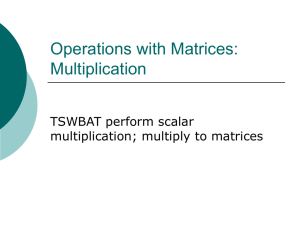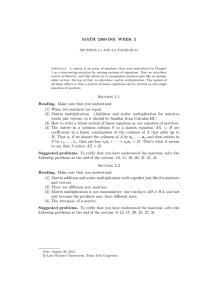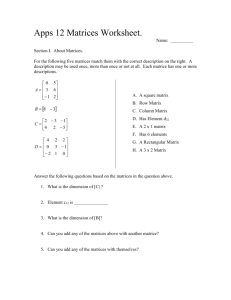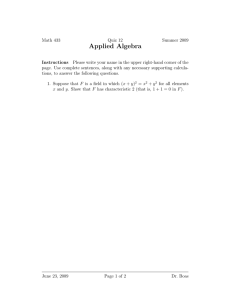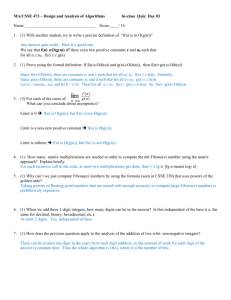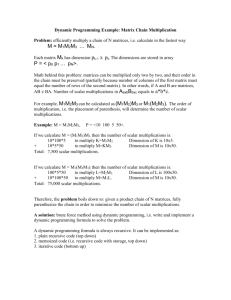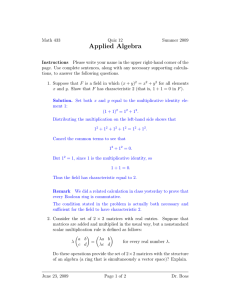Computer science problems.
advertisement
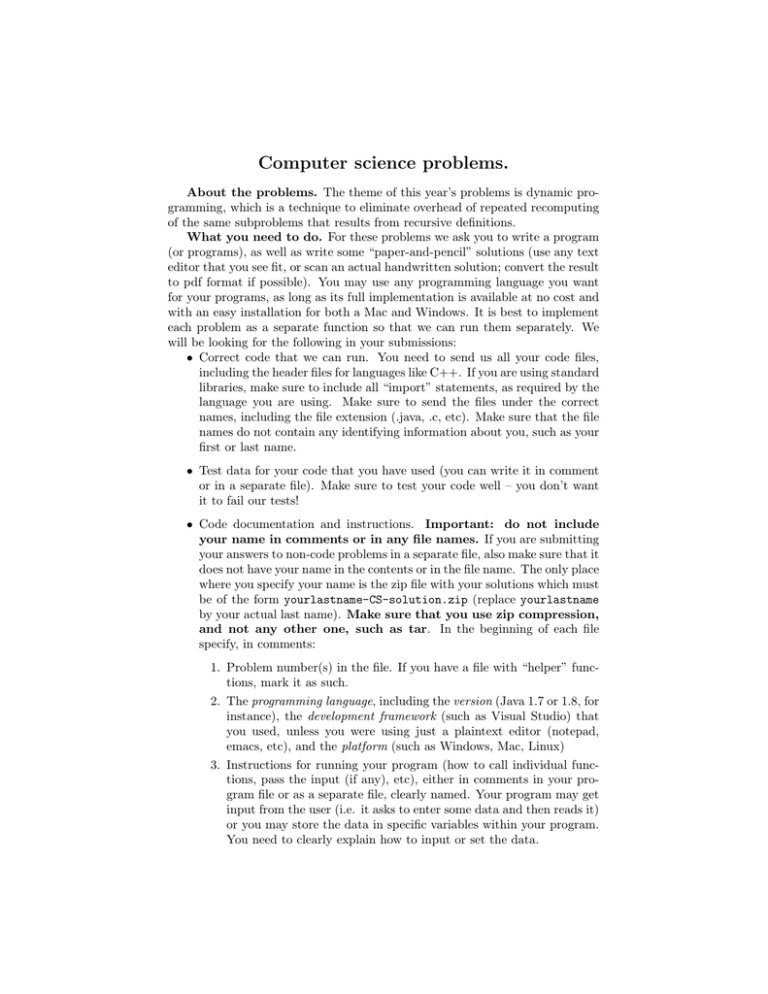
Computer science problems.
About the problems. The theme of this year’s problems is dynamic programming, which is a technique to eliminate overhead of repeated recomputing
of the same subproblems that results from recursive definitions.
What you need to do. For these problems we ask you to write a program
(or programs), as well as write some “paper-and-pencil” solutions (use any text
editor that you see fit, or scan an actual handwritten solution; convert the result
to pdf format if possible). You may use any programming language you want
for your programs, as long as its full implementation is available at no cost and
with an easy installation for both a Mac and Windows. It is best to implement
each problem as a separate function so that we can run them separately. We
will be looking for the following in your submissions:
• Correct code that we can run. You need to send us all your code files,
including the header files for languages like C++. If you are using standard
libraries, make sure to include all “import” statements, as required by the
language you are using. Make sure to send the files under the correct
names, including the file extension (.java, .c, etc). Make sure that the file
names do not contain any identifying information about you, such as your
first or last name.
• Test data for your code that you have used (you can write it in comment
or in a separate file). Make sure to test your code well – you don’t want
it to fail our tests!
• Code documentation and instructions. Important: do not include
your name in comments or in any file names. If you are submitting
your answers to non-code problems in a separate file, also make sure that it
does not have your name in the contents or in the file name. The only place
where you specify your name is the zip file with your solutions which must
be of the form yourlastname-CS-solution.zip (replace yourlastname
by your actual last name). Make sure that you use zip compression,
and not any other one, such as tar. In the beginning of each file
specify, in comments:
1. Problem number(s) in the file. If you have a file with “helper” functions, mark it as such.
2. The programming language, including the version (Java 1.7 or 1.8, for
instance), the development framework (such as Visual Studio) that
you used, unless you were using just a plaintext editor (notepad,
emacs, etc), and the platform (such as Windows, Mac, Linux)
3. Instructions for running your program (how to call individual functions, pass the input (if any), etc), either in comments in your program file or as a separate file, clearly named. Your program may get
input from the user (i.e. it asks to enter some data and then reads it)
or you may store the data in specific variables within your program.
You need to clearly explain how to input or set the data.
4. Some of your code may be commented out if it is not used in the
final run of your program. Make sure it is clear what needs to be
uncommented to run code for each of the problems.
5. All of your test data.
6. If you were using sources other than the ones listed here (i.e. textbooks, online resources, etc) for ideas for your solutions, please clearly
credit these contributions. This is a courtesy to work of others and
a part of ethics code for scholars.
• Clear, understandable, and well-organized code. This includes:
1. Clear separation between problems; comments that help find individual problems and explain how to run the corresponding functions.
2. Breaking down code into functions that are clearly named and described (in comments), using meaningful names for variables and
function parameters. Your code should be as self-explanatory as
possible. While using comments helps, naming a variable average
is better that naming it x and writing a comment “x represents the
average”.
3. Minimization of code repetition. Rather than using a copy-paste
approach, use functions for repeated code and reuse these functions.
4. Using well-chosen storage structures (use an array or a list instead of
ten variables, for instance) and well-chosen programming constructs
(use loops or recursion when you can, rather than repeated code).
5. While we are not asking for the fastest program (it’s better to make
it more readable), you should avoid unnecessary overhead.
Problem 1. Fibonacci numbers are a well-known sequence of numbers
defined as follows:
F1 = 1,
F2 = 1,
Fn = Fn−1 + Fn−2 for all n > 2.
1. What is F8 ?
2. Write a function that takes a single positive integer n and returns Fn .
Your function must implement the definition directly, i.e. it must be
making two recursive calls for every n > 2. As for all problems, please
include tests for your function.
3. How many function calls does your function make in order to compute
F5 ? What are those function calls?
4. Explain how the number of these calls would grow when n increases. Why
is this not a reasonable way of computing Fibonacci numbers?
Problem 2. We use the example of Fibonacci numbers to introduce approaches that will be used later in the problem set. While there are other, more
direct, ways of computing Fibonacci numbers, we will explore optimizations
that we can make based on just the definition by eliminating the overhead of
unnecessarily repeated function calls.
One of the approaches is known as memoization and is based on storing
results of function calls the first time the function is called with a given set of
parameters, and then using the stored results instead of recomputing them.
More specifically, the program maintains a table of calls to a given function.
The table contains the parameter(s) and the result. Every time the function is
called, a lookup is performed to see if the table already contains the results for
given parameter(s). If it does, the result from the table is returned. Otherwise
the computation proceeds (although recursive calls then may perform their own
lookups). Once the result is computed, it is added to the table and returned
from the function.
1. For this problem, please write a new version of the Fibonacci function
that performs memoization. As before, make sure to test it thoroughly.
You may use any data structure of your choice to maintain the lookup
table. However, even if your programming language supports automated
memoization, you have to implement it on your own.
2. How many function calls does your program make for n = 5? For n = 100?
Please explain your answer.
Problem 3. You may have noticed that the table of results in memoization
is being filled in the increasing order of function parameters: first n = 1, then
for n = 2, and so on. That is because the results for higher numbers depend on
those of the lower ones. This indicates that instead of performing a sequence of
function calls top-down (from higher numbers to lower ones), one can compute
Fibonacci numbers bottom-up (from F1 and F2 up to Fn ) in a loop. The loop will
require two variables to keep two most recently computed Fibonacci numbers.
Each next iteration will replace the current Fk and Fk+1 numbers with Fk+1
and Fk+2 = Fk + Fk+1 , respectively. The loop will start with F1 and F2 and
continue until the n-th Fibonacci number is computed.
Write a function that takes n and returns Fn . The function must have only
a loop, no recursion or a table.
Problem 4: optimal matrix multiplication problem. Notation: in this
problem we use × for matrix multiplication and · for multiplication of numbers
(also referred to as scalar multiplication).
The following problem is described in Chapter 15 of [1] in more detail. In
physics and graphics processing one often needs to multiply a large number of
matrices of various dimensions. Recall that the product of an n × m (where n is
the number of rows, m is the number of columns) matrix A and an m×k matrix
Pk
B is an n×k matrix C with entries ci,j = l=1 ai,l b,lj , where ai,l and bl,j refer to
the elements of the matrices A and B respectively. Thus, in order to produce one
element of C one needs to perform m scalar multiplications, i.e. multiplications
of individual elements. The total number of scalar multiplications to compute
C is n · m · k.
The product of two matrices A and B is defined only if the number of
columns of A is the same as the number of rows of B. We call such matrices
compatible.
Consider multiplying matrices A1 × A2 × A3 × A4 that have the following
dimensions:
A1 : 5 × 4,
A2 : 4 × 2,
A3 : 2 × 10,
A4 : 10 × 3.
1. Suppose one performs the multiplications left-to-right: ((A1 × A2 ) × A3 ) ×
A4 . How many scalar multiplications would be performed?
2. How many scalar multiplications are performed when the multiplication
proceeds right-to-left: A1 × (A2 × (A3 × A4 ))?
Briefly explain your answers.
Problem 5. Since not all ways of multiplying matrices require the same
number of scalar multiplications, we will consider the following problem. The
matrix chain multiplication problem is defined as follows: given a sequence of
matrices A1 , A2 , . . . An , where Ai has dimensions pi−1 × pi , and Ai−1 and Ai are
compatible for all 1 ≤ i ≤ n, determine the order of computing A1 ×A2 ×· · ·×An
with the minimum number of scalar multiplications. Note that the problem
does not ask you to multiply the matrices, just to figure out the optimal way of
multiplying them.
Let m[i, j] denote the optimal (minimal) number of scalar multiplications
to multiply matrices from an index i to an index j (1 ≤ i ≤ j ≤ n) in a given
matrix sequence. m[i, j] is defined recursively as follows:
(
0
if i = j
m[i, j] =
min {m[i, k] + m[k + 1, j] + pi−1 · pk · pj } if i < j
i≤k<j
Apply this formula to determine the optimal way of multiplying A1 × A2 × A3
(i.e. the case when i = 1, j = 3) in the example in the previous problem. Also
determine the optimal way of multiplying A2 × A3 × A4 . Show your work.
Problem 6. One may use the formula in Problem 5 to construct a recursive
solution for the matrix chain multiplication problem, where each computation
of m[i, j] is implemented as its own function call, with the case i = j acting
as the base case. How many function calls does one need to make to compute
m[1, 4]? How many of these calls are with parameters for which the answer has
been previously computed?
Now consider a problem with 5 matrices. How many calls (total) one would
make, and how many of these calls repeat parameters of previously computed
calls?
If one were to use a memoization approach, how many function calls would
they be making for n = 4 and n = 5?
Please explain your answers. You don’t need to implement a recursive solution or a solution with memoization.
Problem 7. The previous problem indicates that a naive recursive solution
results in repeated calls to the function that computes m[i, j] for the same values
of i and j. These repeated calls constitute overlapping subproblems. While it is
possible to use memoization to minimize the number of function calls, there is
also a bottom-up approach that builds the solutions from smaller ones to larger
ones in a table, similar to how Fibonacci are computed in a loop in Problem 3. A
bottom-up approach to an optimization problem with overlapping subproblems
is known as dynamic programming.
In the case of matrix chain multiplication the solution is constructed by filling in the following table that shows values of m[i, j] for all 1 ≤ i ≤ j ≤ n. The
table is filled up bottom-up, applying the equation given in Problem 5. The
bottom row represents the number of scalar multiplications m[i, i] performed
in “multiplying” a sequence of just one matrix (which is the base case of the
definition, with the value 0). The second row consists of the optimal costs (the
number of scalar multiplications) in multiplying pairs of neighboring matrices,
so it represents values m[1, 2], m[2, 3], . . . . The third row from the bottom represents the optimal costs of multiplying groups of three matrices: m[1, 3], which
is the optimal cost of multiplying A1 × A2 × A3 , then m[2, 4], which is the optimal cost of multiplying A2 × A3 × A4 . The top row has only one element that
contains the solution for the entire sequence, from the first matrix to the last
one.
For instance, for a sequence of four matrices the table is as follows:
m[1, 4]
m[1, 3]
m[1, 2]
m[1, 1]
m[2, 4]
m[2, 3]
m[2, 2]
m[3, 4]
m[3, 3]
m[4, 4]
Consider the dimensions of the matrices given in Problem 4. We start filling
in the table bottom-up for this case:
?
? ?
40 80 60
0 0 0 0
The bottom row of the table represents the base case which is all 0s. The
second row represents the number of multiplications in multiplying two matrices:
the first cell is the cost of multiplying A1 × A2 which is 5 · 4 · 2 = 40 scalar
multiplications, the second cell corresponds to A2 × A3 which is 4 · 2 · 10 = 80,
and the last cell is the cost of A3 × A4 which is 2 · 10 · 3 = 60. Note that there
is no choice involved in filling in the bottom two rows of the table.
The third row contains m[1, 3] and m[2, 4] that you have computed in Problem 5. Fill in these values. Then compute m[1, 4] (the cost of the optimal way
of multiplying all four matrices) using the equation in Problem 5. Show your
work. Also show the parentheses in the sequence of four matrices that group
the matrices in the way that produces the optimal solution.
Problem 8. Implement the dynamic programming solution (the one described in the previous problem) for any sequence of matrices. Specifically, your
program must take input given as n (the number of matrices in the sequence)
and the sequence of n + 1 numbers as dimensions p0 , p1 , . . . pn (the matrices assume to be compatible). The program must produce the total number of scalar
multiplications in the optimal solution, as well as the full set of parentheses in
the solution, for instance:
(A1 ∗ ((A2 ∗ A3) ∗ A4))
Here ∗ stands for multiplication (since most programming languages cannot
represent ×). You may skip, or include, the outer set of parentheses.
Your program must implement dynamic programming, not memoization.
If two or more ways of putting parentheses produce the same result, either
one can be produced by your program.
Please test your program on the sequence of 5 matrices with the dimensions
as follows: 30, 20, 10, 40, 5, 25. Submit your results (the minimal number of
scalar multiplications and the parentheses for the case when it happens).
Problem 9: breaking up a string. Now consider the following problem:
A certain string processing language allows the programmer to break a string
into two pieces. Since this involves copying the old string into two new locations,
it costs n units of time to break a string of n characters into two pieces. There
is no operation that allows you to break a string into more than two pieces
at once. For instance, breaking a string into three pieces requires breaking it
into two pieces twice (with the corresponding copying). Suppose a programmer
wants to break a string into many pieces. The order in which the breaks are
made can affect the total amount of time used. For example suppose we wish
to break a 20 character string after characters 2,8, and 10:
• If the breaks are made in left-right order, then the first break costs 20
units of time, the second break costs 18 units of time and the third break
costs 12 units of time, a total of 50 steps.
• If the breaks are made in right-left order, the first break costs 20 units of
time, the second break costs 10 units of time, and the third break costs 8
units of time, a total of only 38 steps.
Come up with an optimal solution (by hand) for breaking a string of 20 units
after the characters 2, 8, and 10. Show all your work.
Problem 10. Describe a recursive solution for this problem. It must contain
a recursive definition, similar to the one in Problem 5. Make sure to define your
notations; don’t forget about the base case.
Explain what overlapping subproblems arise in the recursive solution.
Problem 11. Describe a dynamic programming solution as a table that gets
filled up in a bottom-up fashion. Fill in the table for the example in Problem 9.
Implement your solution using dynamic programming or memoization. Make
sure that your solution shows both the total number of copied characters and
the order of the positions at which the string is broken.
Your program must take the length of the string and the sequence of break
positions as inputs. It should output the total number of copied characters in
the optimal solution, as well as the order of positions at which the string is
broken. The example format of the sequence is 2, 10, 5 indication that first the
string is broken after the second character, then after the 10th character of the
original string, and then after the 5th character of the original string.
Submit your results for the example in Problem 9.
Problem 12. Suppose a friend tells you that there is no need in constructing
a bottom-up solution since the optimal number of copies can always be achieved
by choosing the break closest to the middle in a top-down fashion. For instance,
if a string of 20 units needs to be broken after characters 2, 5, 11, and 17, then
choosing the break at 11 (closest to 10, which is the middle) would lead to the
best solution.
Do you agree that this strategy guarantees the best solution? If yes, please
clearly explain why. If not, please show an example for which this is not the
case.
References
[1] T. H. Cormen, C. E. Leiserson, R. L. Rivest, and C. Stein. Introduction to
Algorithms. The MIT Press, 3rd edition, 2009.
